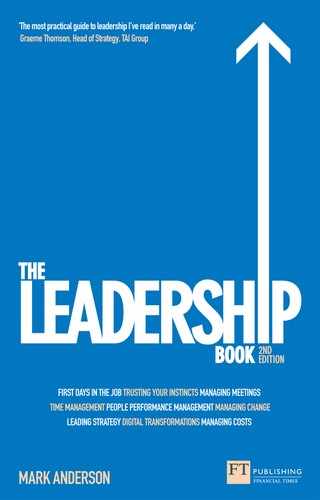Introduction to the first edition
Purpose
Anyone picking up yet another book on the subject of leadership could be forgiven for wondering if there was any point in a new one given how much has been written on the subject over the last few years. My thoughts exactly – as I contemplated just why I wanted to write this book and how I was going to approach it.
My first exposure to business leadership came in the 1980s when I was recruited as a graduate trainee to work in the publishing industry for the organisation then known as Longman. I knew nothing about the world of work, nothing about publishing and nothing about ‘running’ anything. But I worked for someone who, while they consistently mocked everything related to ‘management’, represented something else very special – example and inspiration. And when I subsequently took an MBA at Ashridge, I came to realise that the qualities I admired so much in my line manager (who was, of course, sceptical about the entire concept of an MBA) were defined as ‘leadership’.
After my MBA I was catapulted into running a video training business, which I think I did exquisitely badly. I assumed that all the theories learned during a management programme would be readily accepted by a willing and open-minded (and largely young) workforce – failing to realise that their overriding perception was that a 29-year-old with little experience of anything was an unattractive and, quite literally, incredible role model. Yet it taught me a lesson, and perhaps the one lesson that is the hardest to prepare for in an MBA programme – success in business depends entirely on people, and that there s no programme or course or degree that is a substitute for experience.
That very first line manager of mine was a natural leader, but my experience of experience has taught me that effective leadership skills can be acquired, nurtured and developed; that organisational structures which place a heavy emphasis on process and governance can suppress leadership instincts; and that being a successful leader is, more than anything else, reflected in day-today business behaviours.
Which is where this book came in. ‘Leadership’ is demonstrably a subject that is much written about, but it tends to be elusive. I was struck by how many current books on the subject analyse leadership either from a theoretical perspective, seeking to identify an abstract unifying theme that determines leadership, or from the vantage-point of a celebrated CEO, whose personal (usually said to be ‘charismatic’) successes are presented as a model for leadership action. While these very different approaches are clearly valid, they tend to avoid the harshest of harsh realities – that to be a leader day-to-day in the teeth of tough and volatile circumstances, there is no time for theory and the experience doesn’t feel theoretical, it feels all too real. However much we might aspire to be a Jack Welch or an Alan Sugar, most leaders are not CEOs of large multi-nationals and have to succeed without the trappings or profile of current, or likely, celebrity.
In an increasingly volatile business environment, there has never been a greater need for leaders who are able to marshal excellent performance, where leadership is not an end in itself but focuses on the optimisation of an organisation’s major differentiation – its human capital. Demands on leadership are also complex; they follow no set pattern. The very challenges of global volatility that demand sustained leadership responses, also demand a leadership that is flexible, multi-faceted and, where necessary, international in perspective.
Perhaps one of the greatest challenges faced by a leader of any team is the necessity to confront a paradox – planned uncertainty. To deliver sustained leadership in the teeth of planned uncertainty requires not only a tenacity of purpose but also an attention to detail – an understanding that effective leadership lies not in grand gestures but in relentless engagement with people through every aspect of an organisation’s quotidian existence. Effective leadership is both in the strategy and the detail, and The Leadership Book tries to demonstrate how.
The Leadership Book is not about rules for management – it is about suggesting ways to enhance performance through maximising the performance of people by respecting their inherent and unique value; it is about recognising that the effective leader must infuse such an approach across a wide range of activities.
How to use this book
The Leadership Book is organised into 11 parts, which I believe represent the key areas that any leader of any team of any size will face on a day-to-day basis. Each part is sub-divided into specific action topics. All the individual action topics have been written entirely independently and I intend that you should dip into those that you feel are relevant to you at any point in your working life.
Each of the action topics has the following structure:
- a headline description including a leadership ‘star rating’;
- the objective – why you should take this subject seriously as a leader;
- the context – how the subject fits into the broader pattern of leadership issues;
- the challenge – why the subject can be difficult to deal with;
- success – how to deal with the issue effectively;
- leaders’ measures of success – three ways you can assess your progress;
- pitfalls – what to beware of;
- a leadership checklist – a summary reminder of key strategies.
